*Offer expires 04/30/24 at 3 a.m. ET. Some exclusions apply.
*Offer expires 04/30/24 at 3 a.m. ET. Some exclusions apply.
by Tom Gaylord
Copyright PyramydAir.com ©2009. All Rights Reserved.
This article originally appeared in Airgun Illustrated magazine in 2003. It's reprinted here with the permission of the author and has been updated.
Velocity has always been at the top of the air pistol shooter's wish list, because air pistols have historically been much less powerful than their longarm cousins. While Webley finds it easy to pump out 30 foot-pounds from their Patriot springer, they don’t get one-fifth as much from their most powerful air pistol.
A few decades back, BSA produced the Scorpion, an extremely power spring pistol. And what a bruiser it was! Velocity was reported as being in the region of 510 to 540 fps. With today's lightweight lead pellets, this would probably increase to slightly more than 550 fps; and with hyper-velocity synthetic pellets, perhaps over 600 fps. According to the seventh edition of the Beeman catalog (1980), there was a more powerful model that the British Government requested be withdrawn, and the report adds that it was impossible to modify the pistol being sold to achieve this higher power.
The Scorpion performed more like a small breakbarrel rifle that had been converted into a too-large spring pistol, though it probably wasn't. The heavy cocking effort was panned by writers everywhere, and the huge forward lunge on firing made shooters think that accuracy was impossible. The air pistol weighed 54 oz., for gosh sakes! In short, it was large, heavy and unpleasant to shoot. The firearm equivalent might be a 6-lb. revolver chambered for the 45/70 cartridge.
Part of the problem of putting power into an air pistol is legislation, and another part is pure physics. In the UK, an air pistol that generates over 6 ft-lbs of muzzle energy is, by law, a firearm and subject to more restrictive laws. In Germany, where a large population of airgun makers reside, the laws don't discriminate between rifles and pistols--ALL have to be under 6 ft-lbs or too bad! With that kind of environment, where's the motivation to build a powerful pistol?
The other problem--physics--is far more limiting than any manmade laws, especially for a spring-piston powerplant. Put simply, it's very difficult to generate great power in a spring-powered airgun when either the barrel length has to be short or the compression chamber has to be small--or both. In air pistols, size is the greatest limitation to power.
The first modern maker to do anything about power in a true air pistol was Weihrauch, whose HW 45, better known in America as the Beeman P1, is a powerhouse. Beeman advertised the P1 as a 600-fps gun in .177 caliber, though nobody I know has ever seen one shoot quite that fast. But a good many of them will top 550 with RWS Hobby pellets, and the American airgun community has come to terms with that. When you see the tiny powerplant that generates all this oomph, you’ll wonder how they managed even that.
RWS has been nipping at Weihrauch's heels in the airgun velocity department ever since the first R1 came head-to-head with the RWS model 45. The R1 was the fairest in the land for several years in the early 1980s until the advent of the RWS 48/52 sidelever. Since the mid-1980s, the two firms have traded speed titles several times. But that was only in their rifle lines. RWS has never posed a challenge to the P1/HW 45 pistol. Until now.
A 700-fps air pistol?
In early 2002, I was shocked to hear RWS announce the new 5G Magnum as a 700-fps air pistol. At first, I believed it had to be a precharged gun because that's the only technology with a chance of attaining that speed, but then I learned that the new 5G Magnum is a spring pistol. Step aside, Weihrauch, there’s a new kid in town!
As I waited for a test gun, I thought about the older models of RWS/Diana model 5 pistols before them. They stretch back to before WWII, with design changes at various times along the way. All model 5 pistols have been powerful (by the standards of their day) breakbarrel spring pistols. The most recent version, which is now replaced by the 5G Magnum, shot lighter .177 pellets in the 425 to 450 f.p.s. region. Some very powerful specimens might get up to 475 with the lightest pellets, which is really cooking. They were advertised as reaching 525 by some vendors (not by RWS), but I never saw one go quite that fast. Still, with the speed they honestly did achieve, they were among the most powerful conventional air pistols until the P1 came on the scene.
Changes have been made
When the 5G Magnum finally arrived at my office, I noticed some differences. It shows its 5G heritage, but this is an air pistol, too. The outside shell looks much like the previous gun except for the muzzlebrake, which is a cocking aid. It's made of steel and incorporates the front sight in a dovetail, so it's not an add-on part in any sense of the word. But the greater benefit it provides is a several-inch extension of the barrel to add leverage during cocking. At that time, RWS called it a "barrel weight stabilizer."
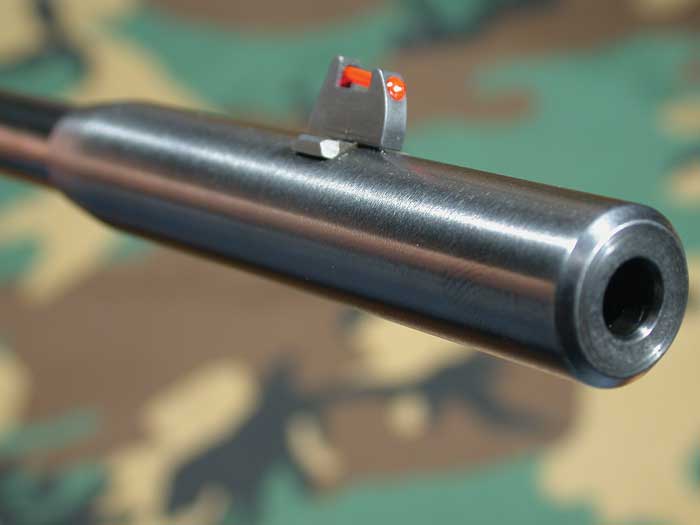
The long, steel muzzlebrake serves as a cocking assist by adding more length to the barrel for better leverage. It also holds the front sight, which is both a square post and a fiber optic sight.
The pistol is a conventional breakbarrel with the trademark RWS ball bearing detent to hold the barrel shut during firing. The cocking effort of the sample we tested is moderate, rather than difficult. The engineers have increased the piston stroke to gain extra power, allowing this pistol to cock easier than the older 5G did.
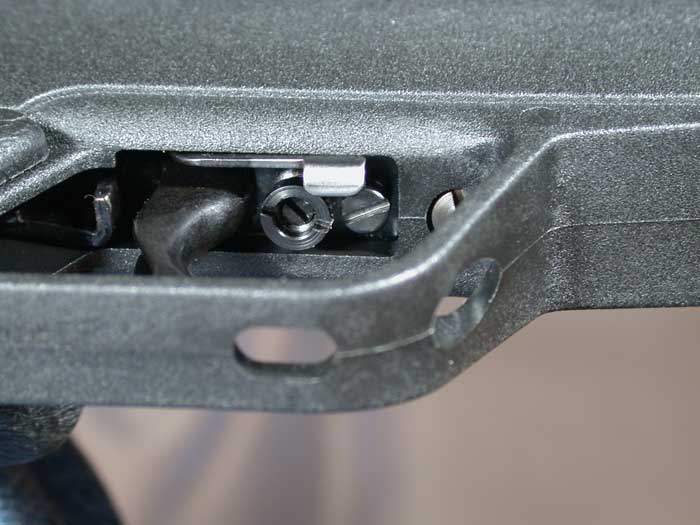
The trigger is adjustable, plus it has an automatic safety that sets every time the pistol is cocked. The silver tab at the top of the trigger slot is pressed in to release the safety. The plain slotted screw in front (at right in this picture) is the locking screw for the trigger mechanism. It makes no adjustments. The hollow slotted screw behind it (just in front of the trigger blade) adjusts the length of first stage travel. Turn it far enough in the counterclockwise direction, and the first stage is eliminated entirely. In the center of the hollow screw is a smaller screw that adjusts trigger-pull weight. Once everything is set to your liking, tighten the front screw to lock the settings.
The trigger is the same as the one on the previous model, but I was unfamiliar with the automatic safety. RWS assured me it had been standard equipment on the 5G for more than a decade.
The key to releasing the automatic safety seems to be to push in AND forward at the same time, because there seems to be resistance to pushing straight in. Perhaps that will disappear after the pistol wears in, but the safety on our test gun still requires it most of the time.
The trigger also adjusts in the same way as the previous model. A front screw locks the settings and a combination screw set (it’s really two different screws) just in front of the trigger lets you adjust both pull weight and first-stage travel. Folks wanting a single-stage trigger-pull can remove all of the first stage to get one.
The grip appears to be the same as on the previous model, and it fits my smallish hand very well. I wonder how it must be for folks with larger hands. There seems to be a tight spot in the formed plastic arch that bears down on the web of the hand, and the arch at the back of the grip keeps your hand in place to feel it. I like it, but I’m not sure everyone else will.
The sights are fully adjustable, with crisp click detents for both windage and elevation. The windage adjustment has a very nice reference scale, so you can actually see which direction the sight is moving. These may seem like small details--the click detents and the scale--but they make sight adjustments so much easier! RWS draws on its target pistol heritage for these small touches that mean so much to a shooter.
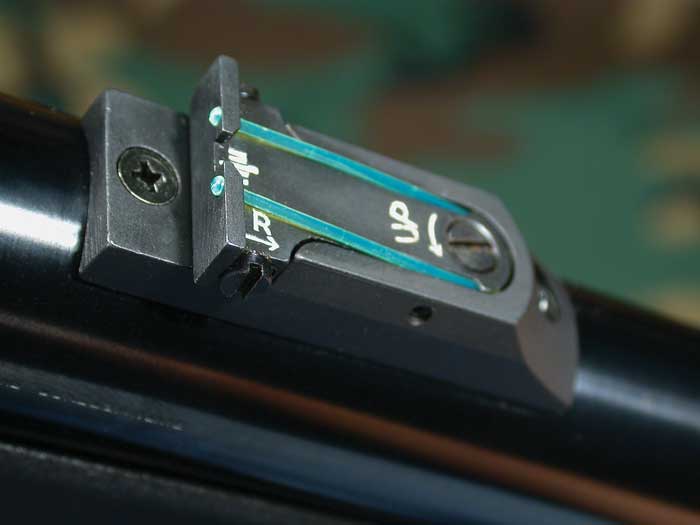
The rear sight has clear markings, crisp detents and fiber optics for fast acquisition. It's a great sporting air pistol sight.
Both sights incorporate fiber optic tubes for added definition to the sight picture. When they're in the proper light, all the shooter has to do is center the front red dot between the two green dots in the rear and fire. Of course, this will change the point of impact from a traditional 6-o'clock hold with the non-illuminated post-and-notch sight picture, but I suspect RWS knows what it's doing. Fiber optic sights are a hot item among shooters today.
The final big difference in the pistol is something of a puzzle. It's marked as a completely different model, yet all the packaging, the owner’s manual and even RWS personnel assure me that this is, in fact, a 5G Magnum. The factory marking on the spring tube says it’s a Diana P5 Magnum.
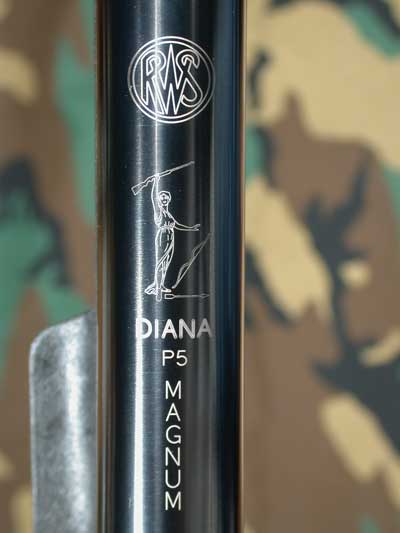
Let there be no confusion. This is what the pistol says, and RWS assures us that the model is the 5G Magnum (officially listed in their catalog as the RWS 5G Magnum P5). If you haven’t seen the logo before, that's the goddess Diana abandoning her bow for an air rifle.
Through the chronograph
This is a spring-piston air pistol, so some time should be allowed for break-in, which was not done for this test. RWS spring guns usually require less of a break-in period, and they're usually as consistent as they will ever be straight from the box. But after a few hundred shots, there should be a small but measurable increase in average velocity. I attribute this to the synthetic piston seal material they use, and to the fact that they don't over-lube their powerplants like some airgun manufacturers do. Only about 100 shots had been fired before the test pistol was chronographed.
.177 cal. RWS 5G Magnum P5 spring-piston air pistol |
|||||||
Muzzle 1' from the start screen, 67 deg. F, all strings were 10 shots |
|||||||
| RWS R10, 8.1 grains | RWS Hobby, 6.9 grains | Skenco Hyper-Velocity, 5.6 grains | |||||
| High | 498 fps |
High | 558 fps |
High | 644 fps |
||
| Low | 479 fps |
Low | 520 fps |
Low | 623 fps |
||
| Average | 483 fps |
Average | 533 fps |
Average | 632 fps |
||
| Extreme spread | 19 fps |
Extreme spread | 38 fps |
Extreme spread | 21 fps |
||
| Standard deviation | 5 fps |
Standard deviation | 12 fps |
Standard deviation | 7 fps |
||
| Muzzle energy | 4.20 ft-lbs |
Muzzle energy | 4.35 ft-lbs |
Muzzle energy | 4.97 ft-lbs |
||
With a hyper-velocity pellet speeding above 630 fps and Hobbys going faster than 530, the 5G Magnum is in the same class as the Beeman P1, which makes it faster than any other spring-powered air pistol on the market today. This is a clear advancement in power over the standard 5G.
If you read the introduction to this report, you can appreciate how difficult it is for a spring-powered pellet pistol to shoot this fast. Some people think it's just up to the designers to get 600 fps or even 900 fps from a pellet pistol--essentially, that anything is possible. That's not the case. While I'm not suggesting that spring pistols will never shoot faster than they do today, it must be understood that we are now on a very steep part of the power curve, and future velocity advances will most likely come in smaller increments. The fact that RWS managed to cram this kind of power boost into a package no larger than their standard 5G pistol is remarkable.
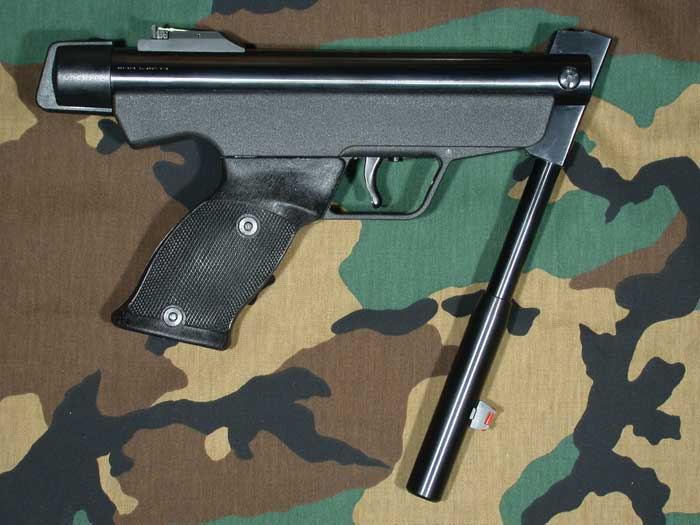
Any questions where the term breakbarrel comes from? The 5G Magnum has a longer piston stroke than the standard model it replaces, so the extra power comes from breaking the barrel open farther--not by a heavier mainspring. Cocking is relatively light for a pistol of this power.
After looking at speed, the next question has to be accuracy. Does the pistol shoot good groups? At the heart of this question is the longer piston stroke, which causes the pistol to move a lot when it fires. In my experience, a shooter should ignore movement like this because there's nothing that can be done about it. In the world of firearms, the M1911 Colt semiautomatic pistol has a deserved reputation for "bouncing" in your hand when it fires. The cure is to ignore the bounce and concentrate on a good trigger release, which is the same thing to do with the 5G Magnum.
This pistol shoots like a rifle
I found that the best accuracy came from a relaxed, two-hand hold rested on a bag. Normally, I shoot pistols better with one hand, but my hands were shaking too much to do the 5G real justice. But with a relaxed two-hand hold--jump back jack!
The best pellet was RWS's own R10 target wadcutter. They grouped as tight as any Beeman P1 or P2 target pistol I've ever tested. All target pellets did well in the 5G Magnum.
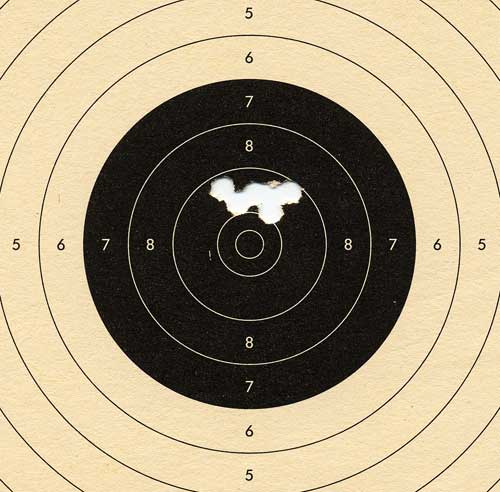
This air pistol shoots like a rifle! This group was made with a rested two-hand hold at 10 meters. Five RWS R10 target pellets went into this group, which measures 0.476 inches c-t-c. Though the pistol moves when it fires, a loose and repeatable hold cancels the movement.
The muzzle flip caused by the long piston stroke is very noticeable when shooting from a rest or when concentrating in any shooting position. You may think it will throw you off target; but if you don't try to fight it, there will be no problems. Just look at the above test target! The pellet is out of the barrel before the major movement begins, so your job is to keep the hold as repeatable as possible, shot after shot. The gun does the rest.
Crosman Premiers gave only mediocre accuracy in the test pistol, but mediocre in this gun would be pretty good in most others. Groups of 1.5 inches were the norm with Premier 7.9-grain pellets at 10 meters.
One thing I did notice while shooting long strings was a tendency for the muzzlebrake to loosen quickly. I advise the use of Loctite 242 thread-locking solution on the two Allen screws that hold the brake in place. Remember, the front sight is mounted on it!
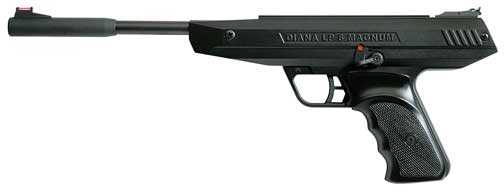
The LP8 will replace the current model in 2009. Like its predecessor, it's advertised to deliver 700 fps.
Summary
The RWS 5G Magnum is a very credible air pistol! It delivers power and accuracy that can only be rivaled but not exceeded by one other spring air pistol. It has the looks, the technology and the solid RWS name going for it. In 2009, Diana is replacing the gun with the LP8 Magnum.
Buy With Confidence
Get FREE shipping on qualifying orders! Any order $150+ with a shipping address in the contiguous US will receive the option for free ground shipping on items sold & shipped by Pyramyd AIR during checkout. Certain restrictions apply.
Free shipping may not be combined with a coupon unless stated otherwise.
View Shipping Info
We work hard to get all orders placed by 12 pm EST out the door within 24 hours on weekdays
because we know how excited you are to receive your order.
Weekends and holiday shipping times will vary.
During busy holidays, we step our efforts to ship all orders as fast as possible,
but you may experience an additional 1-2 day delay before your order ships.
This may also happen if you change your order during processing.
View Shipping Times
It's important to know that due to state and local laws, there are certain restrictions for various products.
It's up to you to research and comply with the laws in your state, county, and city.
If you live in a state or city where air guns are treated as firearms you may be able to take advantage of our FFL special program.
U.S. federal law requires that all airsoft guns are sold with a 1/4-inch blaze orange muzzle
or an orange flash hider to avoid the guns being mistaken for firearms.
View Shipping Restrictions
Get the most out of your equipment when you work with the expert technicians at Pyramyd AIR. With over 25 years of combined experience, we offer a range of comprehensive in-house services tailored to kickstart your next adventure.
If you're picking up a new air gun, our team can test and tune the equipment before it leaves the warehouse. We can even set up an optic or other equipment so you can get out shooting without the hassle. For bowhunters, our certified master bow technicians provide services such as assembly, optics zeroing, and full equipment setup, which can maximize the potential of your purchase.
By leveraging our expertise and precision, we ensure that your equipment is finely tuned to meet your specific needs and get you ready for your outdoor pursuits. So look out for our services when shopping for something new, and let our experts help you get the most from your outdoor adventures.
View Service Info
Shop and purchase with confidence knowing that all of our air guns (except airsoft) are protected
by a minimum 1-year manufacturer's warranty from the date of purchase unless otherwise noted on the product page.
A warranty is provided by each manufacturer to ensure that your product is free of defect in both materials and workmanship.
View Warranty Details
Didn't get what you wanted or have a problem? We understand that sometimes things aren't right and our team is serious about resolving these issues quickly. We can often help you fix small to medium issues over the phone or email.
If you need to return an item please read our return policy.
Learn About Returns
Get FREE shipping on qualifying orders! Any order $150+ with a shipping address in the contiguous US will receive the option for free ground shipping on items sold & shipped by Pyramyd AIR during checkout. Certain restrictions apply.
Free shipping may not be combined with a coupon unless stated otherwise.
View Shipping Info
Want More?
Join Our Email List for News and Deals!
Join the Pyramyd AIR mailing list: Our e-mails are filled with new products, deals, sneak peeks, tips and tricks, contests and more - sign up today!
Text JOIN to 91256 and get $10 OFF Your Next $50+ Order!
* By providing your number above, you agree to receive recurring autodialed marketing text msgs (e.g. cart reminders) to the mobile number used at opt-in from Pyramyd AIR on 91256. Reply with birthday MM/DD/YYYY to verify legal age of 18+ in order to receive texts. Consent is not a condition of purchase. Msg frequency may vary. Msg & data rates may apply. Reply HELP for help and STOP to cancel. See Terms and Conditions & Privacy Policy.